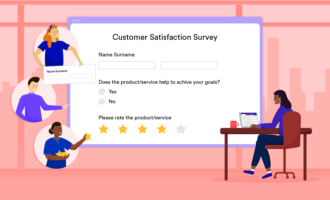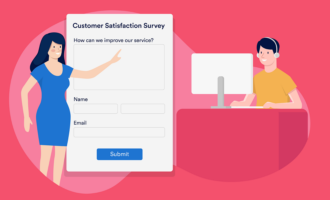Creating an effective customer success process
- Understand the customer
- Create a customer success team
- Outline the communication protocols
- Establish success metrics
Customers play a vital role in any business, no matter the industry. Whether you have a small mom-and-pop retail store or a multinational e-commerce business, keeping your customers happy is the key to success.
There are many ways to meet the needs of your customers, such as providing them with a product or service that helps them solve a specific problem and offering support that’s reliable, consistent, and helpful. To make sure customers get the most out of their relationship with your business, it’s important to have a department focused on ensuring their happiness, with a detailed customer success process in place.
Here’s everything you need to know about customer success and how to create an effective process for creating it.
Understanding customer success (and how it differs from customer service)
You’ve likely heard of customer service, but what’s customer success? They’re interconnected and related parts of a business, but each has a specific role to play.
Customer service is a reactive process. When a customer has a question or problem, the customer service department helps them find an answer or resolve their issue.
Customer success, on the other hand, is a proactive process. It’s about looking for ways to support your customers before any questions or problems arise.
Amanda A. Russo, founder and CEO of Cornerstone Paradigm Consulting, LLC, a business operations consulting firm, notes that, “Customer success managers will follow up with a buyer and make sure the product/platform/service is everything the customer expected. Customer success is relationship building and making sure your product/service/platform is meeting the customer’s goals.”
She goes on to explain, “Customer service can provide a refund, for example, whereas customer success will follow up with the customer to ask how they can help. This is a good opportunity to find out what’s not working for the customer and stay top of mind for them.”
The key goal of customer success is to reduce churn, encouraging customers to return to your business time and time again. Customer success and customer service departments don’t replace one another; they work together to provide value in different ways.
Customer service is necessary to provide support when things go wrong. Customer success helps customers reach their objectives in a proactive way.
A major part of customer success is looking at data to glean insights about what customers want, how they feel, and what they need — and then turning those insights into actionable ways to provide value. “Customer success is a great opportunity to upsell or renew a subscription,” says Russo.
Creating an effective customer success process
A successful customer success process is tailored to the business, and it depends on the industry, competitive landscape, business size, products and services, and many other factors. That said, here are some of the major steps that are commonly required to build any customer success process.
Understand the customer
Having deep insight into who your customers are is a necessity if you want your business to overtake your competition.
Customer success departments conduct research into the demographic, psychographic, and behavioral characteristics of their customers. They know who their customers are and what they’re trying to achieve. They also know the major problems their customers are facing and the types of solutions they’re looking for.
In some organizations, the customer success team is divided into smaller groups, each supporting a different segment of their audience. For example, one group may support small businesses while another supports medium-sized businesses — after all, those audiences have different needs, challenges, and ideal solutions. Companies could also divide customer success into groups that support different product lines.
“When it comes to customer profiles, it’s important to understand the complexities and dynamics of working with different types of customers,” says Russo. “The customer success role really has to understand the specific needs of each kind of end user.”
Create a customer success team
“Customer success is conducted and managed by a designated person or team,” says Russo. “It’s an outreach program designed to connect and manage current clients to ensure your product/service/platform is meeting and exceeding your customers’ expectations.”
Having dedicated team members solely focused on customer success is ideal, as this means they can develop in-depth knowledge of what customers need and how to provide value to them. In smaller organizations, one or two individuals might handle customer success as opposed to an entire department.
Customer success team members typically offer high-touch service to clients for three months after they make a purchase. It’s during this time that customers need the most support in learning how to use the product or service. If organizations want to reduce churn, they have to ensure they properly onboard their customers and give them the knowledge they need to get the most value from their purchase.
Outline the communication protocols
By starting a virtual call center, teams can utilize a dedicated platform alongside multiple communication channels such as one-on-one interactions, email marketing, surveys, and social media to engage with customers more effectively. The key to effective customer success is communication. Many organizations create a customer journey map that identifies where, when, and how the customer success team communicates with customers and what they should talk about. Teams should use multiple communication channels to engage customers, such as one-on-one interactions, email marketing, surveys, social media, and more.
“The organization should be asking the customer for their communication preferences during the onboarding process,” says Russo. “Do they prefer to be emailed or called? It’s really important to establish their communication needs up front.”
Outlining what to discuss during each interaction ensures your customer success team gets the best insights from their engagements. For example, the first interaction may be a phone call where a customer success representative answers any questions the customer has about how to use the product and then shares an instructional video. The fourth interaction may be a short survey with questions about how satisfied the customer is with using the product and the level of service they’ve received.
Establish success metrics
It’s important to track and monitor metrics to understand whether or not your customer success efforts are having a positive effect on the business. Common customer success metrics include churn rate, customer retention rate, customer lifetime value, customer acquisition cost, number of referrals, customer satisfaction rates, and upsell profits.
Russo notes that the different metrics an organization tracks will depend on its industry, products, services, and many other factors. “It will be different in every scenario,” she says.
When customers are happy with the business, they’ll refer others to the company. This helps reduce customer acquisition costs and churn rates, resulting in larger customer lifetime value and higher profitability.
Russo notes that customer success also provides opportunities for achieving other goals, such as getting customer feedback, updating account information, or upselling a new product or service. If these are specific objectives your organization wants to achieve as part of customer success, be sure to outline the metrics so you can track performance at frequent intervals. “Organizations should be looking for ways to create an environment where the customer can’t live without them,” says Russo.
Pro Tip
Try Jotform AI Agents to ensure customer success with personalized, conversational AI interactions available 24/7, and use Jotform AI Survey Generator to create customer surveys effortlessly by uploading a file, writing a prompt, or scanning.
Optimizing the customer success process with the right tools
Gathering and analyzing data is a critical role of customer success. To know what customers are thinking, customer success teams use surveys at different stages in the customer journey. Getting detailed feedback from customers will reveal how they feel about the business and what other kinds of support they need from your organization to reach their goals.
With Jotform, customer success departments can easily create custom surveys, feedback forms, and questionnaires to automate communication with the customer. You can organize, manage, and sort all of the data you gather using Jotform Tables, a no-code spreadsheet tool. You can also use customer feedback logs to manage the responses.
To streamline your customer success process and enhance communication, try Jotform’s Gmail Agent to automate your email replies. With Gmail Agent, your team can respond faster to customer inquiries by automatically drafting responses based on past interactions, FAQs, and tone. It helps ensure your emails remain consistent with your brand while saving valuable time on repetitive tasks.
“Customer demands are changing,” says Russo. “Customers are no longer tolerant of poor behavior. They’re more likely to jump ship and go with a competitor instead of complaining and staying.”
Customer success is all about proactively ensuring you meet your customers’ expectations — before any problems occur. Creating a thorough customer success process will help your organization provide top-notch support and value to your audience, effectively reducing churn and increasing profitability.
Photo by Mikhail Nilov


















Send Comment: